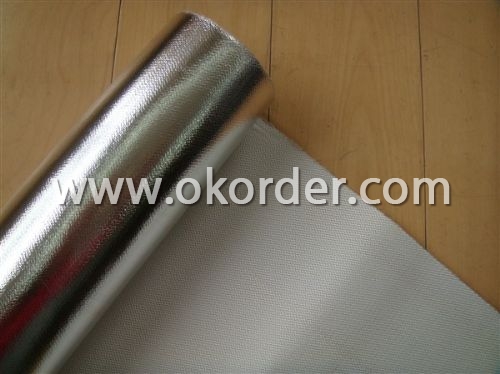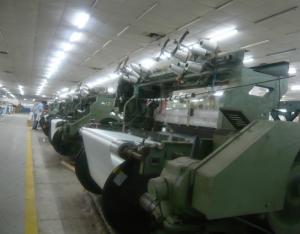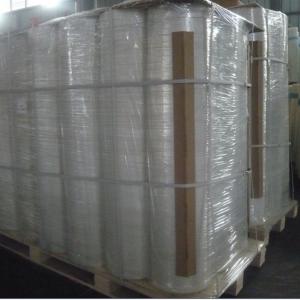Composite Fiberglass Fabrics For Building
- Loading Port:
- Shanghai Port
- Payment Terms:
- TT or LC
- Min Order Qty:
- 10000 M2 m²
- Supply Capability:
- 50000000 M2 Per Year m²/month
OKorder Service Pledge
OKorder Financial Service
You Might Also Like
Introduction of Composite Fiberglass Fabrics:
1. Description & Keyword:
Keywords: fibergalss fabric, fsk, foil scrim kraft, foil scrim kraft paper, foil scrim kraft facing
Alkaline-resistant fiberglass fabrics as backing brings us a stronger and ductile malleable laminates.
2. Structure & Benefits:
With degradable Mylar film as exposure surface, this products supply better reflection.
Application of Composite Fiberglass Fabrics:
[1]. Pack the air-conditioning outlet
[2]. Could be cut to wrap around the glass wool in different sizes for inserting between the main body and the inner body of the subway wagons, for insulating against temperature and sound .
[3]. As vapor barrier or moisture proof.
Relatived Similar products guide of Composite Fiberglass Fabrics:
FG701: use aluminum foil instead of the aluminum coated film (Mylar film) in FG701.
FGS701: additional layer of 7micron aluminum foil was applied to FGS701
FG701T: self adhesive tape, easy to install, because of the application of pressure sensitive adhesive, two types we supply: one could endure temperature from -10degree centigrade to 60DC, another one could standing from -10DC to 100DC.

- Q:What are the different applications of fiberglass fabric in the oil and gas industry?
- Fiberglass fabric finds various applications in the oil and gas industry due to its excellent properties such as high strength, corrosion resistance, and thermal insulation. It is commonly used for insulation, fireproofing, and reinforcement purposes in pipelines, tanks, and equipment. Fiberglass fabric is also utilized for manufacturing composite materials in the form of pipes, gratings, and platforms, providing durability and resistance to chemicals and harsh environments. Overall, its versatility and reliability make it an essential material for enhancing safety and performance in the oil and gas sector.
- Q:What are the different weaves available for fiberglass fabric?
- Fiberglass fabric offers a variety of weaves, each with distinct qualities and applications. Among the most commonly used weaves are plain, twill, satin, and leno. The plain weave stands as the simplest and most prevalent option for fiberglass fabric. It consists of an equal number of warp and weft yarns crossing over and under each other in a straightforward pattern. This weave produces a durable and balanced fabric with excellent stability. Twill weave, another popular choice, involves the diagonal crossing of warp and weft yarns, resulting in a noticeable ribbing effect. Compared to plain weave, twill offers enhanced drapability and flexibility, making it ideal for applications requiring greater conformability. Satin weave is a more intricate option, yielding a smooth and lustrous fabric surface. It features long floats of either warp or weft yarns, resulting in fewer interlaced yarns and a lightweight, supple fabric. Satin weave finds its place in applications desiring a high-quality appearance and soft texture, such as clothing and decorative fabrics. Leno weave stands out as a unique option, involving the twisting of adjacent warp yarns to create an open mesh structure. This weave is commonly employed for fiberglass fabrics that require transparency, breathability, filtration, or reinforcement. Ultimately, the choice of weave for fiberglass fabric depends on the specific needs of the application. By considering factors like strength, flexibility, appearance, and breathability, one can select the most suitable weave to achieve optimal performance for their desired purpose.
- Q:How is fiberglass fabric used in the sports and recreation industry?
- Fiberglass fabric is widely used in the sports and recreation industry for its strength, durability, and flexibility. It is commonly used in the manufacturing of sports equipment such as fishing rods, hockey sticks, and tennis rackets, where it provides enhanced performance and resistance to breakage. Additionally, fiberglass fabric is also employed in the production of protective gear, such as helmets and body armor, due to its ability to absorb impact and provide excellent protection.
- Q:How does fiberglass fabric perform in fatigue resistance?
- The fatigue resistance properties of fiberglass fabric are truly remarkable. With its remarkable tensile strength, flexibility, and low weight, this material can endure repeated loading and cyclic stress without any notable degradation or failure. As a result, it is highly suitable for various industries, including aerospace, automotive, and marine, where constant or fluctuating mechanical forces are prevalent. Moreover, the corrosion resistance inherent in fiberglass adds to its durability and long-term performance in environments prone to fatigue. In summary, fiberglass fabric is renowned for its exceptional fatigue resistance, guaranteeing reliability and longevity in demanding applications.
- Q:Can fiberglass fabric be used for making sails?
- Indeed, sails can be crafted using fiberglass fabric. This resilient and long-lasting material is frequently employed in a multitude of uses, including the construction of boats. When employed as a fabric for sail production, fiberglass boasts an exceptional strength-to-weight ratio, enabling the sail to endure turbulent weather conditions and strong winds. Moreover, it is resistant to tearing and stretching, rendering it a dependable choice for sailing enthusiasts. Additionally, a protective coating can be applied to fiberglass fabric to augment its water and UV resistance, guaranteeing the sail's durability. In summary, fiberglass fabric presents a multitude of benefits for the creation of sails, rendering it an esteemed option amongst sailors and sail manufacturers alike.
- Q:How does fiberglass fabric handle moisture?
- Fiberglass fabric has excellent resistance to moisture and is considered to be highly water-resistant. Due to its composition of woven glass fibers, it does not absorb water and is unaffected by moisture or humidity. This makes fiberglass fabric ideal for applications where exposure to moisture is expected, such as boat hulls, outdoor furniture, and building materials. Additionally, fiberglass fabric does not promote the growth of mold or mildew, further enhancing its ability to handle moisture.
- Q:Can fiberglass fabric be used for making safety nets or barriers?
- Yes, fiberglass fabric can be used for making safety nets or barriers. Its high tensile strength, durability, and resistance to heat, chemicals, and weather make it a suitable material for creating reliable safety nets and barriers in various industries, including construction, sports, and transportation.
- Q:What about laying glass fiber cloth on polyurethane waterproof coating?
- Plus no glass fiber cloth is not very different, the key depends on the quality of construction, quality is good.
- Q:How does fiberglass fabric compare to other insulation materials?
- When comparing fiberglass fabric to other insulation materials, it presents a range of advantages and disadvantages. One notable advantage of fiberglass fabric lies in its superior thermal insulation properties. With its low thermal conductivity, it effectively hinders heat transfer. This quality makes it an ideal option for both residential and commercial insulation needs, as it aids in retaining heat during colder months and keeping spaces cool in hotter periods. Moreover, fiberglass fabric is renowned for its durability and longevity. It possesses resistance to moisture, fire, and chemicals, rendering it a dependable choice for insulation purposes. It maintains its effectiveness and insulation properties over many years, as it does not easily degrade with time. Additionally, fiberglass fabric offers versatility and simplicity in installation. It comes in various forms, such as rolls, batts, and loose-fill, making it suitable for different applications. It can be effortlessly cut and shaped to fit any space, facilitating a seamless installation process. Furthermore, it does not necessitate specialized tools or equipment for installation, resulting in a cost-effective choice. Nonetheless, fiberglass fabric does have certain drawbacks that warrant consideration. One major concern revolves around the potential health risks associated with handling fiberglass. The minuscule glass fibers can become airborne during installation or if the fabric is damaged, leading to skin irritation, eye problems, and respiratory issues. Thus, it is crucial to wear appropriate protective gear, including gloves and masks, when working with fiberglass fabric. Furthermore, fiberglass fabric possesses relatively lower sound insulation capabilities when compared to certain other materials. While it does offer some level of soundproofing, it may not be as effective in reducing noise transmission as specialized soundproofing materials like foam or cellulose insulation. In conclusion, fiberglass fabric provides exceptional thermal insulation, durability, and ease of installation. However, it is important to be mindful of the potential health risks and its limitations in terms of sound insulation. It is advisable to consult professionals and consider specific requirements before selecting fiberglass fabric as an insulation material.
- Q:Can fiberglass fabric be used for making automotive parts?
- Yes, fiberglass fabric can be used for making automotive parts. It is commonly used in the manufacturing of car bodies, hoods, fenders, and other components due to its high strength-to-weight ratio, durability, and resistance to corrosion.
1. Manufacturer Overview |
|
|---|---|
| Location | Shandong, China |
| Year Established | 2002 |
| Annual Output Value | Below US$1 Million |
| Main Markets | North America; South America; Eastern Europe; Southeast Asia; Africa; Oceania; Mid East; Eastern Asia; Western Europe; Central America; Northern Europe; Southern Europe; South Asia |
| Company Certifications | ISO 9001:2000 |
2. Manufacturer Certificates |
|
|---|---|
| a) Certification Name | |
| Range | |
| Reference | |
| Validity Period | |
3. Manufacturer Capability |
|
|---|---|
| a)Trade Capacity | |
| Nearest Port | Qingdao Port |
| Export Percentage | 81% - 90% |
| No.of Employees in Trade Department | Above 10 People |
| Language Spoken: | English; Chinese; |
| b)Factory Information | |
| Factory Size: | Above 10,000 square meters |
| No. of Production Lines | Above 10 |
| Contract Manufacturing | Design Service Offered; Buyer Label Offered |
| Product Price Range | High; Average |
Send your message to us
Composite Fiberglass Fabrics For Building
- Loading Port:
- Shanghai Port
- Payment Terms:
- TT or LC
- Min Order Qty:
- 10000 M2 m²
- Supply Capability:
- 50000000 M2 Per Year m²/month
OKorder Service Pledge
OKorder Financial Service
Similar products
New products
Hot products
Related keywords



























